八年级英语unit9 第三课时教案
渝水区第八中学八年级英语下册Unit9Haveyoueverbeentoamuseum第三课时Sec

第三课时Section A (Grammar Focus4c)1.重点单词:German,theme,province2.重点句式:—I've been to the art museum many times.—Me,too.And I've also visited the nature museum.—I've never been to a water park.—Me neither.I've already been there a couple of times,but I'm happy to go again.There are some special German paintings there right now.Disneyland is an amusement park with a special theme.Have you ever been to another province in China?1.现在完成时态的用法2.所学过的各种时态的区别各种时态的灵活运用一、预习课本P68新单词并背诵,完成下面的汉译英。
1.德国的____________2.主题____________3.省份________二、认真预习Grammar Focus4c找出下列句型。
1.—我去过艺术博物馆很多次。
—我也是。
而且我还参观了自然博物馆。
________________________________________________________________________ ________________________________________________________________________ 2.—我从来没有去过水上公园。
—我也没有去过。
________________________________________________________________________ ________________________________________________________________________ 3.我已经去过那里几次了,但是我还是很高兴再次去那里。
人教版英语八年级上册Unit9课时优秀教学案例
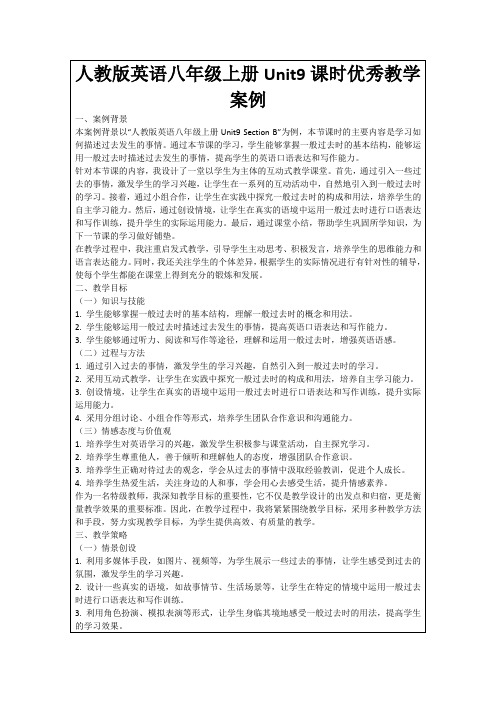
4.反思与评价:在教学过程中,教师和学生共同总结学习内容和收获,帮助学生巩固所学知识。同时,教师鼓励学生自我反思,思考自己在学习过程中的优点和不足,制定相应的学习策略。这种反思与评价的教学策略能够培养学生的自我监控和自我调整能力,使学生能够持续地改进自己的学习方法和策略。
3.创设情境,让学生在真实的语境中运用一般过去时进行口语表达和写作训练,提升实际运用能力。
4.采用分组讨论、小组合作等形式,培养学生团队合作意识和沟通能力。
(三)情感态度与价值观
1.培养学生对英语学习的兴趣,激发学生积极参与课堂活动,自主探究学习。
2.培养学生尊重他人,善于倾听和理解他人的态度,增强团队合作意识。
五、案例亮点
1.情境创设:本案例通过引入生动、真实的情境,如故事情节、生活场景等,让学生身临其境地感受一般过去时的用法,提高了学生的学习兴趣和积极性。这种情境创设不仅有助于学生理解一般过去时的概念,还能够激发学生的想象力和创造力,使学生在实践中掌握语言知识。
2.问题导向:在教学过程中,教师设计了一系列问题,引导学生主动思考、积极探索。这种问题导向的教学策略能够培养学生的批判性思维和独立思考能力,使学生在解决问题的过程中自然地引入和运用一般过去时。同时,教师鼓励学生提问,培养了学生的自信心和勇气。
人教版英语八年级上册Unit9课时优秀教学案例
一、案例背景
本案例背景以“人教版英语八年级上册Unit9 Section B”为例,本节课时的主要内容是学习如何描述过去发生的事情。通过本节课的学习,学生能够掌握一般过去时的基本结构,能够运用一般过去时描述过去发生的事情,提高学生的英语口语表达和写作能力。
人教版八年级下册英语第九单元3a教案

人教版八年级下册英语第九单元3a教案课程名称:英语第九单元3a授课计划一、教学目标•知识目标:学习和掌握本单元重点词汇和短语;学习使用第三人称单数形式;学会阅读关于家庭成员信息的短文。
•能力目标:提高学生的听说读写能力,培养学生的合作与沟通能力。
•情感目标:培养学生的家庭伦理观念,增强对家庭的理解和珍惜。
二、教学重难点•教学重点:单词和短语的记忆与应用。
•教学难点:运用第三人称单数形式进行简单的交流和叙述。
三、教学准备•教学工具:多媒体课件,教学PPT等。
•教学材料:人教版八年级下册英语教材,学生作业本。
四、教学步骤与内容步骤一:导入新知1.创设情境:与学生进行简单的问候和交流,激发学生对家庭话题的兴趣。
2.引入新词汇:通过PPT呈现并解释本单元重点词汇和短语,如relatives、cousin、grandmother等。
步骤二:学习新知1.学习第三人称单数形式:通过示范和操练,教授第三人称单数动词的变化规则,并让学生进行口头练习和小组对话练习。
2.阅读短文:教师带领学生阅读并理解3a部分的短文,然后进行一些相关问题的讨论,提醒学生注意细节。
步骤三:拓展应用1.合作对话活动:将学生分成小组,设计有关家庭成员的对话情景,要求学生运用所学知识进行对话练习,鼓励创新思维和表达能力。
2.反馈与总结:收集学生展示的对话内容,并进行评价和点评,帮助学生发现并纠正错误,总结本节课所学内容。
步骤四:课堂作业1.阅读:要求学生复习并默读3a部分的短文,并在作业本上写出自己的家庭成员信息。
2.巩固练习:布置相关习题,包括填空和改写句子的练习,以进一步巩固所学知识。
五、教学评价•教师根据学生在课堂活动中的表现和作业完成情况,进行个别评价和小结,及时反馈和引导学生的学习。
六、板书设计Unit 9 My family- Vocabulary: relatives, cousin, grandmother, etc.- Grammar: Third person singular form of verbs- Reading: Family member introduction七、教学反思本节课采用了多种教学方法,包括展示、讨论、口头练习和合作对话,旨在培养学生的英语听说读写能力和合作能力。
人教版新目标八年级英语上册Unit 9集体备课教案设计
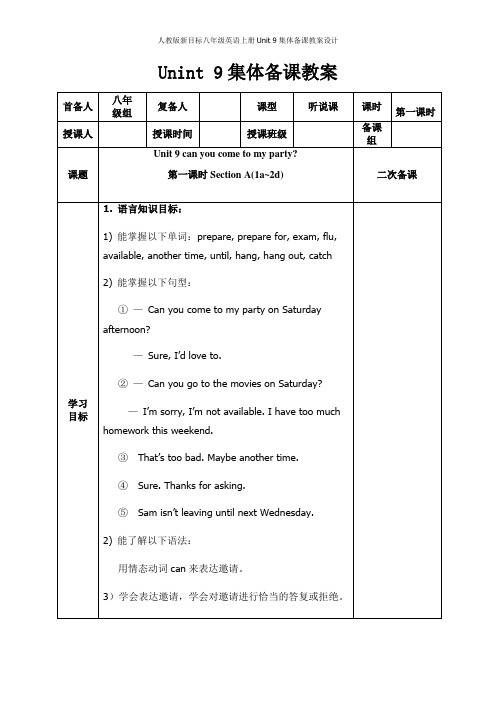
Conversation 4
Anna: Mei Ling, can you come to my party on Saturday?
Mei Ling: Sorry, but I’m not available. I must study for a math test.
我怕是没空来帮着准备学校19号演出了。
2. I have an exam on Monday so I must prepare for it.
prepare作动词,意为“使做好准备;把……准备好”,常用短语有prepare for sth.和prepare to do sth.,前者意为“为某事做准备”,后者意为“准备做某事”。如:
Sun Ning: Hey, Ted. Can you come to my party on Saturday afternoon?
Ted: I’m sorry, I can’t, Sun Ning. I have to help my parents.
Sun Ning: Too bad. How about you, Jenny? Can you come to my party?
Mary: I’d love to. Do I need to bring anything?
Anna: No, I’ll buy all the food and drinks.
Conversation 3
Anna: May, can you come to my party tomorrow?
May: I’m afraid not. I have the flu.
八年级英语外研版小学起点上Module 9 Unit 教案
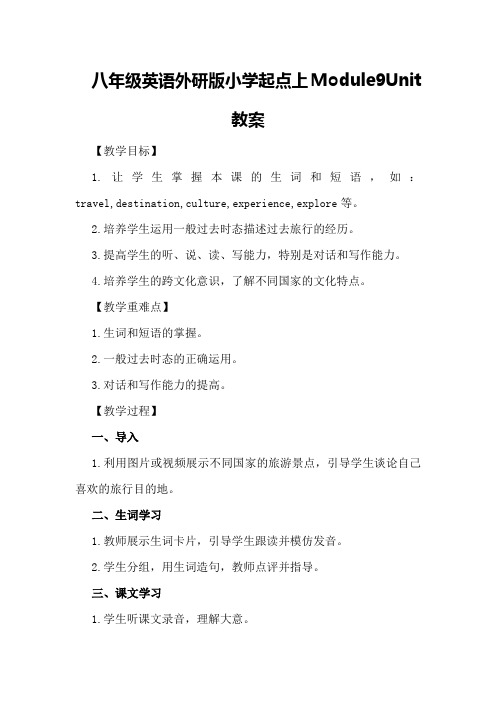
八年级英语外研版小学起点上Module9Unit教案【教学目标】1.让学生掌握本课的生词和短语,如:travel,destination,culture,experience,explore等。
2.培养学生运用一般过去时态描述过去旅行的经历。
3.提高学生的听、说、读、写能力,特别是对话和写作能力。
4.培养学生的跨文化意识,了解不同国家的文化特点。
【教学重难点】1.生词和短语的掌握。
2.一般过去时态的正确运用。
3.对话和写作能力的提高。
【教学过程】一、导入1.利用图片或视频展示不同国家的旅游景点,引导学生谈论自己喜欢的旅行目的地。
二、生词学习1.教师展示生词卡片,引导学生跟读并模仿发音。
2.学生分组,用生词造句,教师点评并指导。
三、课文学习1.学生听课文录音,理解大意。
2.教师提问,检查学生对课文的理解。
3.学生分角色朗读课文,注意语音、语调。
4.教师讲解课文中的难点和重点句子。
四、语法学习1.教师讲解一般过去时态的用法和构成。
2.学生完成练习,巩固一般过去时态。
3.学生用一般过去时态描述自己的旅行经历,教师点评并指导。
五、对话练习1.学生分组,模拟课文中的对话。
2.教师巡回指导,纠正发音和语法错误。
3.学生展示对话,其他学生评价。
六、写作练习1.教师提出写作任务:描述一次难忘的旅行经历。
2.学生讨论写作思路,列出要点。
3.学生独立完成作文,教师点评并指导。
七、拓展活动1.学生分组,设计一次旅行计划,包括目的地、行程、预算等。
2.各组展示旅行计划,其他学生提问或给出建议。
八、课堂小结1.教师回顾本节课的学习内容,检查学生对知识点的掌握。
2.学生分享学习心得,提出疑问。
3.教师布置作业,要求学生复习课文和生词。
【作业布置】1.复习课文和生词,熟读课文。
2.完成课后练习,巩固一般过去时态。
3.准备下一次课的对话和写作内容。
【教学反思】本节课通过生词学习、课文学习、语法学习、对话练习、写作练习和拓展活动等多种形式,让学生在轻松愉快的氛围中学习英语。
人教版英语八年级上册Unit9课时说课稿
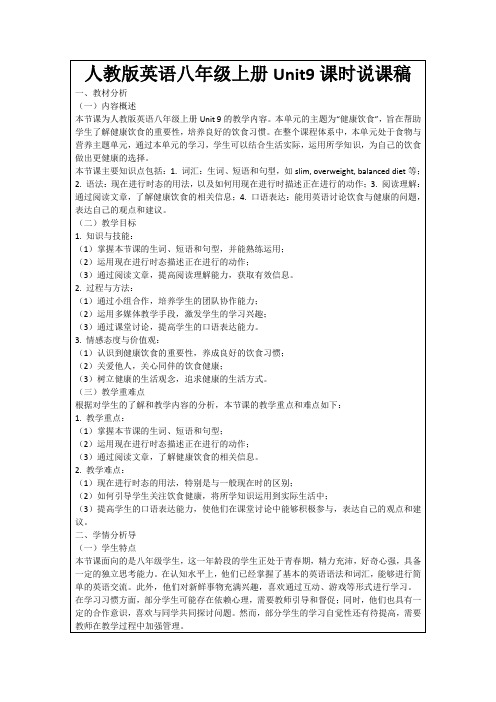
为了帮助学生巩固所学知识并提升应用能力,我计划设计以下巩固练习或实践活动:
1.设计填空、选择、改错等书面练习,让学生在实际语境中运用现在进行时。
2.创设情境,让学生进行角色扮演,用英语讨论健康饮食的话题,提高口语表达能力。
3.小组合作,设计一份健康饮食宣传海报,展示所学知识,培养团队协作能力。
(四)总结反馈
在总结反馈阶段,我将采取以下措施:
1.让学生自我评价,反思本节课的学习收获和不足之处。
2.教师针对学生的表现给予评价,强调优点,指出不足,并提供具体的改进建议。
3.组织学生互相评价,学会欣赏他人,取长补短,共同提高。
(五)作业布置
课后作业的目的是巩固所学知识,提高学生的应用能力。我将布置以下作业:
(二)媒体资源
我将使用以下教具、多媒体资源和技术工具来辅助教学:
1.教具:实物、图片、卡片等,用于创设情境,激发学生的学习兴趣。
2.多媒体资源:PPT、视频、音频等,用于展示教学内容,丰富课堂表现形式,提高学生的学习积极性。
3.技术工具:投影仪、电脑、平板等,用于实现课堂的数字化、智能化,方便学生随时查阅资料、进行互动。
三、教学方法与手段
(一)教学策略
在本节课中,我将采用任务型教学法、情景教学法和合作学习法作为主要教学方法。
1.任务型教学法:通过设置具体的任务,让学生在实际操作中运用所学知识,提高他们的语言运用能力。这种方法的依据是建构主义学习理论,认为学习是学习者主动建构知识的过程,通过完成任务,学生能够更好地理解和内化知识。
板书的风格将简洁明了,采用不同颜色粉笔突出重点,使知识结构一目了然。板书在教学过程中的作用是帮助学生梳理和记忆知识点,同时作为视觉辅助,增强课堂讲授的直观性。
八年级英语上册 Unit 9(When was he born)教学设计 人教新目标版 教案
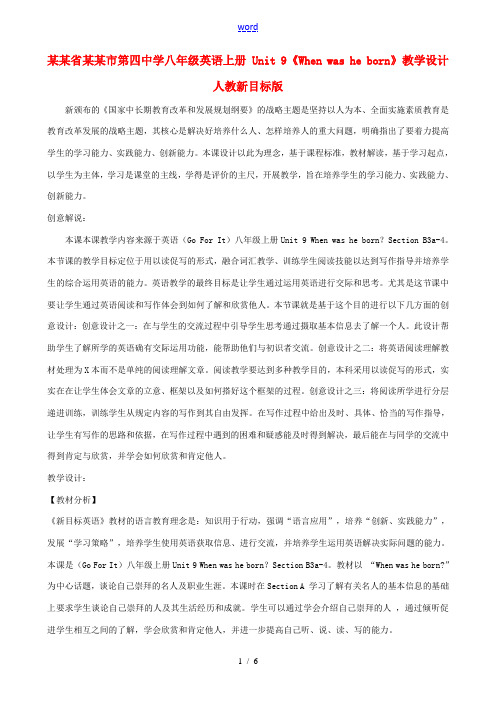
某某省某某市第四中学八年级英语上册 Unit 9《When was he born》教学设计人教新目标版新颁布的《国家中长期教育改革和发展规划纲要》的战略主题是坚持以人为本、全面实施素质教育是教育改革发展的战略主题,其核心是解决好培养什么人、怎样培养人的重大问题,明确指出了要着力提高学生的学习能力、实践能力、创新能力。
本课设计以此为理念,基于课程标准,教材解读,基于学习起点,以学生为主体,学习是课堂的主线,学得是评价的主尺,开展教学,旨在培养学生的学习能力、实践能力、创新能力。
创意解说:本课本课教学内容来源于英语(Go For It)八年级上册Unit 9 When was he born?Section B3a-4。
本节课的教学目标定位于用以读促写的形式,融合词汇教学、训练学生阅读技能以达到写作指导并培养学生的综合运用英语的能力。
英语教学的最终目标是让学生通过运用英语进行交际和思考。
尤其是这节课中要让学生通过英语阅读和写作体会到如何了解和欣赏他人。
本节课就是基于这个目的进行以下几方面的创意设计:创意设计之一:在与学生的交流过程中引导学生思考通过摄取基本信息去了解一个人。
此设计帮助学生了解所学的英语确有交际运用功能,能帮助他们与初识者交流。
创意设计之二:将英语阅读理解教材处理为X本而不是单纯的阅读理解文章。
阅读教学要达到多种教学目的,本科采用以读促写的形式,实实在在让学生体会文章的立意、框架以及如何搭好这个框架的过程。
创意设计之三:将阅读所学进行分层递进训练,训练学生从规定内容的写作到其自由发挥。
在写作过程中给出及时、具体、恰当的写作指导,让学生有写作的思路和依据,在写作过程中遇到的困难和疑惑能及时得到解决,最后能在与同学的交流中得到肯定与欣赏,并学会如何欣赏和肯定他人。
教学设计:【教材分析】《新目标英语》教材的语言教育理念是:知识用于行动,强调“语言应用”,培养“创新、实践能力”,发展“学习策略”,培养学生使用英语获取信息、进行交流,并培养学生运用英语解决实际问题的能力。
外研版八年级英语上册M 9 Unit 3 教案

Unit 3 Language in use【教学目标】To use the points in Units 1 and 2;To use the points in units 1 and 2 freely;To make Ss learn about the environment pollution and how to protect the environment.【教学重点】To master the word, the numbers and the article.【教学难点】The using of the number and the article.【教学方法】PWP method, Formal and interactive practice【教学手段】A tape recorder, multimedia and some pictures【教学过程】Teaching Procedures:Step 1 Revision and lead-inLook at the picture and read the numbers aloud to practice how to read the numbers.Step 2 Language practiceTo master the structure of the grammar1. Beijing is a huge city.2. It takes an hour to get there by bus.3. That’s almost one fifth of the world’s population.4. That makes over 131.4 million births a year.Step 3 Match the countries with their populations1.Match the countries with their populations in groups.1) China a) 4,437,0002) the US b) 22,956,0003) Australia c) 314,791,0004) New Zealand d) 1,370,537,0002.Read your answers to Activity 1 to the whole class.3. Now listen and check.Step 4 Learning to learnTo learn how to see a table and a chartWhen you see a table or a chart, look carefully at the labels and graphs to make sure that youunderstand what they are showing. Look at the chart below. What is it comparing? What can you conclude?Step 5 Read the chart and answer the questionsRead the chart and answer the questions.1. Which city had the largest population in 2000?2. Which city’s population will incr ease most from 2000 to 2025?3. Which city will have a larger increase in its population, New York or Mexico City?4. Which city/cities will have the biggest population problem? Why?Step 6 Write a, an or the where necessary1.Read the passage carefully.2.Then use the articles to fill in the blanks where necessary.Mina is (1) ____ eighteen-year-old girl. She’s got (2) ____ brother and (3) ____ sister.Mina is (4) ____ oldest child in (5) _____ family. She lives in (6) ____ very big city. She has (7) ___ job in (8) ____ hotel. She hopes that one day she will have (9) ___ chance to go to (10) ___ college.Step 7 Complete the sentences with the correct form of the words in the boxFirst read the sentences and use the right form of the words from the box to fill in the blanks.1. We believe the schools in Arnwick are very good, and we’re working to make them even _______.2. Their flat is too large for two people. They want to find a _______ one.3. Anna always talks about her ideas. I think she needs to listen ________.4. There are a lot of parks in this city. I think there are ______ parks in a lot of other cities. Step 8 Complete the diagram showing population problems1.Read the diagram.e the words from the box to complete the diagram.3.To get the answers from the Ss.Problems of ArnwickPeople move from _______________People arrive in _________Problems: Population __________Environmental problems Health problems Problems for the government。
人教新目标八年级英语上册教案:Unit 9 Can you come to my party
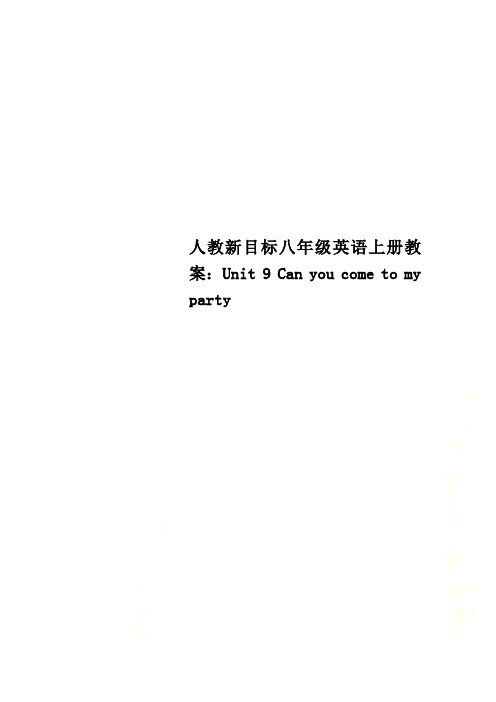
人教新目标八年级英语上册教案:Unit 9 Can you come to my party重点词组1.prepare for 2.have the flu 3.another time4.catch you on Monday 5.hang out 6.the daybeforeyesterday7.the dayaftertomorrow8.look after9.take a trip10.lookforward to11.turn down12.besurprised13.hear fromsb.重点句式1.—Can you come to my party on Saturday? —Sure, I'd loveto./Sorry,I must study for a math test. 2.—Can he go to the party?—No,hecan't.He has to help his parents.单元语法情态动词 can 表示邀请的用法学情分析学生的抽象思维能力较低,形象思维能力强,但注意力容易分散,本单元教学过程中可以对话表演、个人汇报、角色表演等形式展开,并配以适合年龄特点的课件展示,从而增强学生的兴趣和注意力。
第一课时Section A (1a~1c)类别课时要点重点单词1.exam(n.)考试2.prepare(v.)使做好准备3.flu(n.)流感重点词组4.prepare for为……做准备 5.have the flu 得流感6.have to 必须,不得不 7.go to see a/the doctor 去看医生重点句式8.—Can you come to my party on Saturday afternoon? 周六下午你能来参加我的聚会吗?—Sorry, I can't. 对不起,我不能来。
9.I have to prepare for an exam. 我得为考试做准备。
【人教版】2020八年级英语上册 Unit 9 Can you come to my party教案 (新版)人教新目标版
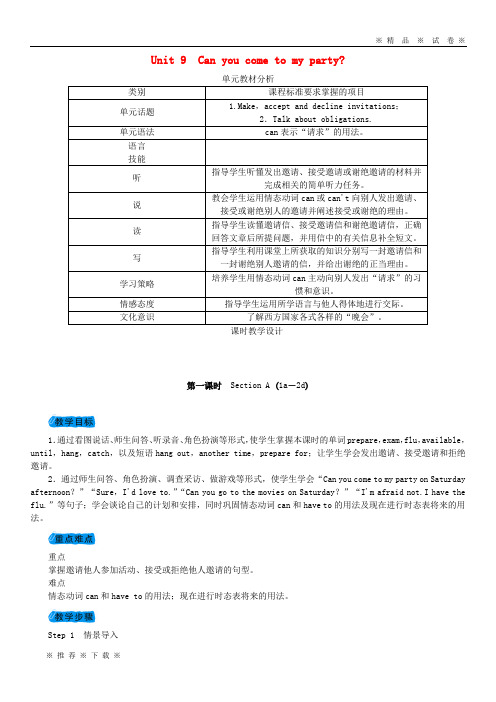
Unit 9 Can you come to my party?课时教学设计第一课时Section A (1a-2d)1.通过看图说话、师生问答、听录音、角色扮演等形式,使学生掌握本课时的单词prepare,exam,flu,available,until,hang,catch,以及短语hang out,another time,prepare for;让学生学会发出邀请、接受邀请和拒绝邀请。
2.通过师生问答、角色扮演、调查采访、做游戏等形式,使学生学会“Can you come to my party on Saturday afternoon?”“Sure,I'd love to.”“Can you go to the movies on Saturday?”“I'm afraid not.I have the flu.”等句子;学会谈论自己的计划和安排,同时巩固情态动词can和have to的用法及现在进行时态表将来的用法。
重点掌握邀请他人参加活动、接受或拒绝他人邀请的句型。
难点情态动词can和have to的用法;现在进行时态表将来的用法。
Step 1 情景导入通过自由交际进行复习热身。
For example:T:I'm very glad to see you again.Boys and girls! My birthday is coming. I am having a paty.Do you like parties?Ss:Yes.T:What can you do at a party?S1:I can dance.S2:I can sing.S3:I can play games.S4:I can meet some new friends.S5:I can talk with my friends.T:I am glad you can do so many things.Can you help me prepare for it?Ss:Of course.T:Thank you.Can you come to my party?You can say,“Sure,I'd love to.”If you can't come,you can say,“I'm sorry,I can't.I have to do…”or “I'm sorry,I can't.I'm doing…”Ss:Yes.(设计意图:通过师生自由交际复习热身并导入新课,谈论如何发出邀请、接受邀请和拒绝邀请,激发学生的学习兴趣。
八年级英语上册Unit9 教案新版人教新目标版
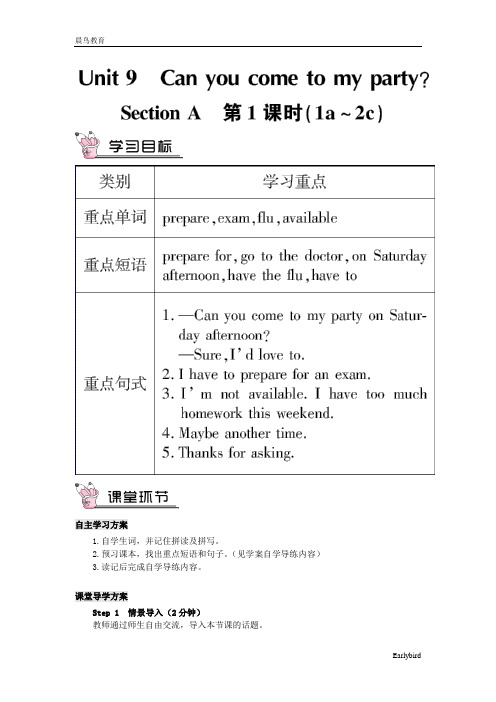
自主学习方案1.自学生词,并记住拼读及拼写。
2.预习课本,找出重点短语和句子。
(见学案自学导练内容)3.读记后完成自学导练内容。
课堂导学方案Step 1 情景导入(2分钟)教师通过师生自由交流,导入本节课的话题。
T:Hi, class, I will have a party at home tomorrow .Can you come to my birthday party?S1: Sure, I’d love to.S2:Sorry,I can’t .I have to …(学生列举原因)如:I have to prepare for my English exam.I have to help my parents with housework.I have to look after my baby sister.I have to meet my friend at the station.I am ill.I have the flu.…环节说明:由过生日邀请学生参加生日聚会引出将要学习的新句型,过渡自然,简洁明了。
Step 2 完成教材1a—1c的任务1.教师通过读音规则和构词法,引导学生记忆词汇的音、形、意。
(学生领读)(3分钟)如:prepare for=get ready for, exam=examination ,flu=cold ,available=free2.学生听1b的录音,完成1b任务。
(3分钟)3.核对答案。
(单独提问与集体回答相结合)(2分钟)4.教师让学生根据1c提供的信息编写对话,练习新的目标句型“Can you come to my party?”及肯定回答和否定回答。
(利用1a的短语)(5分钟)5.小结训练。
(3分钟)(D)(1)I usually watch TV with parents _____ Sunday evening.A.inB.atC.forD.on(C)(2)—What is your mother doing?—She is preparing ____ dinner for us.A.inB.atC.forD.to(B)(3)—Can you come to my birthday party?—____________.A.Yes,I doB.Sorry,I can’tC.No,I’d love toD.Sorry,I don’t(4)他得流感了,不得不去看医生。
八年级英语下册unit9教案
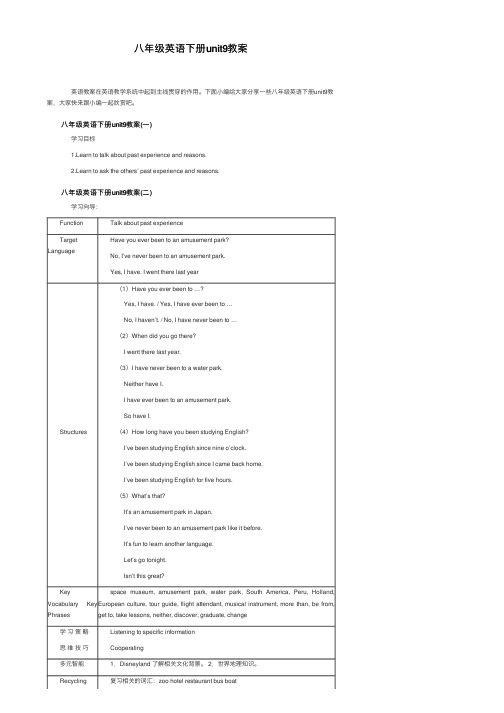
⼋年级英语下册unit9教案 英语教案在英语教学系统中起到主线贯穿的作⽤。
下⾯⼩编给⼤家分享⼀些⼋年级英语下册unit9教案,⼤家快来跟⼩编⼀起欣赏吧。
⼋年级英语下册unit9教案(⼀) 学习⽬标 1.Learn to talk about past experience and reasons. 2.Learn to ask the others’ past experience and reasons. ⼋年级英语下册unit9教案(⼆) 学习向导:Function Talk about past experienceTarget Language Have you ever been to an amusement park? No, I’ve never been to an amusement park. Yes, I have. I went there last yearStructures(1)Have you ever been to …?Yes, I have. / Yes, I have ever been to …No, I haven’t. / No, I have never been to …(2)When did you go there?I went there last year.(3)I have never been to a water park.Neither have I.I have ever been to an amusement park.So have I.(4)How long have you been studying English?I’ve been studying English since nine o’clock.I’ve been studying English since I came back home. I’ve been studying English for five hours.(5)What’s that?It’s an amusement park in Japan.I’ve never been to an amusement park like it before. It’s fun to learn another language.Let’s go tonight.Isn’t this great?Key Vocabulary Key Phrasesspace museum, amusement park, water park, South America, Peru, Holland, European culture, tour guide, flight attendant, musical instrument, more than, be from, get to, take lessons, neither, discover, graduate, change学习策略思维技巧Listening to specific information Cooperating多元智能1.Disneyland 了解相关⽂化背景。
人教版初中八年级英语下册第九单元Unit 9 教案含教学反思

Section A 单词camera n.照相机;摄影机;摄像机unbelievable adj.难以置信的;不真实的progress v.&n.进步;进展rapid adj.迅速的;快速的unusual adj.特别的;不寻常的toilet n.坐便器;厕所encourage v.鼓励social adj.社会的peaceful adj.和平的;安宁的perfect adj.完美的;完全的itself pron.它自己collect v.收集;采集German adj.德国的;德语的;德国人的n.德语;德国人ride n.供乘骑的游乐设施;短途旅程province n.省份amusement n.娱乐;游戏somewhere adv.在某处;到某处invention n.发明;发明物invent v.发明;创造performance n.表演;演出theme n.主题短语amusement park游乐场lead to导致put up搭起think about考虑make tea沏茶tea art 茶艺tea set茶具equator n.赤道短语take a holiday度假three quarters四分之三at night在夜晚all year round全年be close to 靠近be far from远离……thousands of 数以千计的;许许多多的whether…or…不管……还是……on the one hand…on the other hand…一方面……另一方面……句型1.On the one hand,more than three quarters of the population are Chinese,so you can simply speak Putonghua a lot of the time. On the other hand,Singapore is an English-speaking country,so it’s also a good place to practice your English! 一方面,超过四分之三的人口是华裔,因此很多时候你可以只说普通话。
八年级英语下册(人教版)Unit9第3课时SectionA(3a3c)教学设计

3.能够正确使用频率副词,如always, usually, often, sometimes, never等,表达日常饮食的规律。
4.能够运用目标词汇和句型进行有关食物和饮食习惯的对话交流,提高英语口语表达能力。
B: I always have porridge and eggs. I love the fresh taste of eggs, but I don't like porridge that much because it tastes too plain.
2.收集并整理关于不同国家和地区饮食习惯的资料,如图片、文字描述等。下节课向同学们分享,以拓展大家的知识面。
(4)在实际语境中,运用所学知识进行流畅的对话交流。
(二)教学设想
1.针对重点内容,采用以下教学策略:
(1)利用实物、图片等直观教具,帮助学生形象地理解和记忆形容词;
(2)设计丰富的课堂活动,如角色扮演、情景对话等,让学生在实际语境中运用一般现在时态和频率副词;
(3)通过小组合作、讨论等形式,引导学生互相交流,提高口语表达能力。
2.各小组讨论结束后,进行分享,让其他同学了解不同同学的饮食习惯。
3.教师引导学生关注健康饮食,讨论如何养成良好的饮食习惯。
(四)课堂练习
1.教师根据教材中的3c部分设计练习题,让学生运用一般现在时态和频率副词描述日常饮食习惯。
2.学生进行角色扮演,模拟在不同场景下(如餐厅、家庭等)的对话交流,提高英语实际运用能力。
八年级英语下册(人教版)Unit9第3课时SectionA(3a3c)教学设计
人教版八年级英语上册《nit 9 Can you come to my party. Section A .3a—3c》优质课教案_19
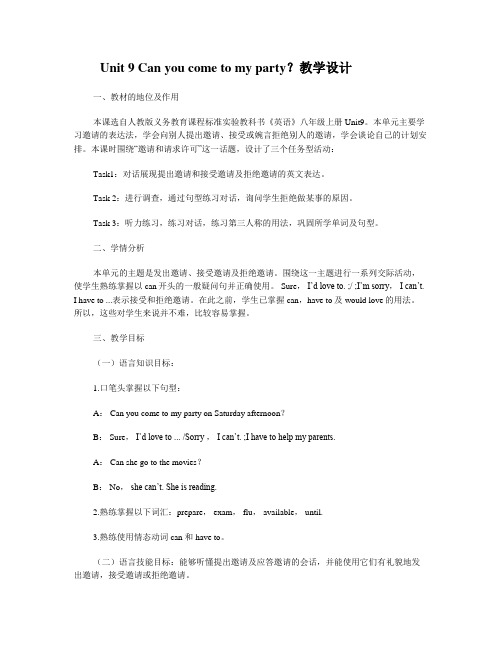
Unit 9 Can you come to my party?教学设计一、教材的地位及作用本课选自人教版义务教育课程标准实验教科书《英语》八年级上册Unit9。
本单元主要学习邀请的表达法,学会向别人提出邀请、接受或婉言拒绝别人的邀请,学会谈论自己的计划安排。
本课时围绕“邀请和请求许可”这一话题,设计了三个任务型活动:Task1:对话展现提出邀请和接受邀请及拒绝邀请的英文表达。
Task 2:进行调查,通过句型练习对话,询问学生拒绝做某事的原因。
Task 3:听力练习,练习对话,练习第三人称的用法,巩固所学单词及句型。
二、学情分析本单元的主题是发出邀请、接受邀请及拒绝邀请。
围绕这一主题进行一系列交际活动,使学生熟练掌握以can开头的一般疑问句并正确使用。
Sure,I’d love to. ;/ ;I’m sorry,I can’t.I have to ...表示接受和拒绝邀请。
在此之前,学生已掌握can,have to及would love的用法。
所以,这些对学生来说并不难,比较容易掌握。
三、教学目标(一)语言知识目标:1.口笔头掌握以下句型:A: Can you come to my party on Saturday afternoon?B: Sure,I’d love to ... /Sorry ,I can’t. ;I have to help my parents.A: Can she go to the movies?B: No,she can’t. She is reading.2.熟练掌握以下词汇:prepare, exam, flu, available, until.3.熟练使用情态动词 can 和have to。
(二)语言技能目标:能够听懂提出邀请及应答邀请的会话,并能使用它们有礼貌地发出邀请,接受邀请或拒绝邀请。
(三)情感态度:培养学生有礼貌地与他人交往的能力。
四、教学重、难点(一)教学重点:1. 运用所学提出邀请,接受邀请和拒绝邀请。
八年级英语上册-人教版-Unit 9 教案

八年级英语上册-人教版-Unit 9 教案一. 教材分析人教版八年级英语上册Unit 9主要围绕着“节假日”这一主题展开,通过学习本单元,学生能够掌握关于节日的词汇和表达方式,了解不同国家的节日习俗,提高听说读写的能力。
本单元包括两个阅读文本,分别是关于春节和西方节日的介绍。
二. 学情分析八年级的学生已经具备了一定的英语基础,能够听懂并运用简单的日常英语进行交流。
但部分学生在阅读和写作方面还存在一定的困难,对一些文化背景知识了解不足。
因此,在教学过程中,需要关注学生的个体差异,调动他们的学习积极性,提高他们的综合语言运用能力。
三. 教学目标1.知识目标:学生能够掌握关于节日的词汇和表达方式,了解不同国家的节日习俗。
2.能力目标:学生能够听懂、说清、读懂并写出一个关于节日的短文。
3.情感目标:培养学生对不同文化的尊重和理解,提高他们的跨文化交际意识。
四. 教学重难点1.重点:掌握关于节日的词汇和表达方式,了解不同国家的节日习俗。
2.难点:能够运用所学知识,编写一个关于节日的短文。
五. 教学方法1.任务型教学法:通过完成各种任务,激发学生的学习兴趣,提高他们的实践能力。
2.情境教学法:创设真实的语境,让学生在实践中学习,提高他们的语言运用能力。
3.文化教学法:介绍节日背后的文化背景,培养学生对不同文化的尊重和理解。
六. 教学准备1.教师准备:备好相关节日的教学材料,如图片、视频、阅读文本等。
2.学生准备:预习相关节日的词汇和表达方式,了解自己国家的节日习俗。
七. 教学过程1.导入(5分钟)教师通过提问方式引导学生谈论自己喜欢的节日,从而引出本课主题。
2.呈现(10分钟)教师展示与节日相关的图片和视频,引导学生用英语描述图片内容。
3.操练(15分钟)教师学生进行角色扮演,模拟节日场景,让学生在实际语境中运用所学知识。
4.巩固(10分钟)教师给出一个关于节日的句子,要求学生用所学的词汇和表达方式进行改写。
八年级英语下册Unit9+Have+you+ever+been+to+a+museum全单元教案
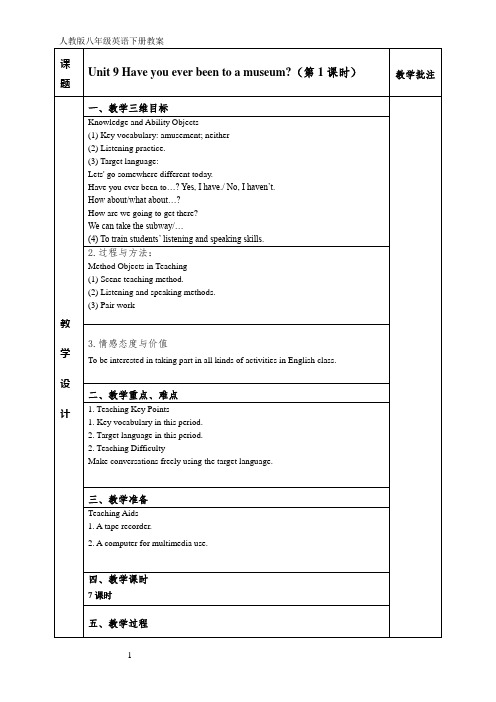
教学设计Listen again. Listen and check the boxes. Have these students ever been to these places?SciencemuseumHistorymuseumArt museum NaturemuseumSpace museum ClaudiaSarah √Step 5 SpeakingAsk and answer in pairs:A: let’s go somewhere different today.B: OK. Where do you want to go?A: Have you ever been to the space museum?B: No, I haven’t. How about you?A: …Step 6 Listening 2a 2bListen and circle the places that you hear.Listen again and circle T for true or F for false.Conversation 11. Tina went to the space museum last year. T/F2. John has never been to the space museum. T/F3. They are going to take the subway. T/FConversation 21. Linda has been to the amusement park. T/F2. Linda went to the amusement park yesterday. T/F3. Linda is going to the amusement park again by bike. T/FConversation 31. Frank had a great time at the water park. T/F2. Frank’s friend has never been to the water park. T/F3. Frank and his friend are going skating. T/FAnswer: TFT TFT FTTSpeakingLook at the map in 2a and make conversations about the places.A: Have you ever been to the space museum?B: Yes, I have. How about you?A: No, I haven’t.B: Oh, it’s fantastic. Let’s go tomorrow.A: OK. How are we going to get there?B: We can take the subway.SpeakingRole-play the conversation in 2d.Step 1 RevisionWhat do you know about Singapore?position: Where is Singapore?position: in Southeast AsiaPopulationMore than three quarters of the population are Chinese.LanguageChinese and English.FoodA lot of food from China, such as rice, noodles and dumplings.Indian food, western food and Japanese food.ZooSingapore has a special zoo called the “Night Safari”. A lot of animal only wake up at night, so this is the best time to watch them.WeatherThe temperature is almost the same all year round.Step 2 Writing3b Write an article to advertise your hometown or a place you have been to.句型:Have you ever tried/seen/been…?If you…, you will/can…You should…One great thing about …is…Step 3 Self check1. Think about the things below and write an answer for each one.1) One thing that you have collected before:_________________________________2) One invention that you have found to be very useful:_________________________________3) One unbelievable or unusual thing that you’ve seen or hea rd recently:_________________________________4) One way that you’ve used to encourage a friend in the past:_________________________________5) One peaceful and quiet place that you’ve been to recently:________________________________( )35.Which one can be the best title?A. Different animals in TanzaniaB. The ways of traveling in TanzaniaC. Why do we take a bus to travel?D. The beautiful country-TanzaniaBWhen you are in England,you must be very careful in the street because the traffic drives on the left. Before you cross a street,you must look to the right first and then the left. If the traffic lights are red,the traffic must stop. The people on foot can cross the road carefully. If the traffic lights are green,the traffic can go. The people on foot must not cross. In the morning and in the evening when people go to or come from work,the streets are very busy.When you go by bus in England,you have to be careful,too. Always remember the traffic moves on the left.So you must be careful. Have a look first or you will go the wrong way. In many English cities,there are big buses with two floors. You can sit on the second floor. From there you can see the city well. It is very interesting. ( )36.When you are in England, you must be more careful in the street because________.A. there are many cars and buses on the roadB. there are no traffic lightsC. the buses and cars move on the leftD. people on foot may cross the road( )37.In England,before you cross a street, you must look to first and then________.A. the right;the leftB.the left;the rightC. the front;the backD. the back;the front( )38. If the traffic lights are green, can go, mustn’t cross.A. the people on foot;the trafficB. the traffic;the people on bikeC. buses;carsD. the traffic;the pe ople on foot( )39. In England, you must always remember that the traffic _______.A. is busyB. moves on the leftC. moves on the rightD. with two floors ( )40. In many cities in England, there are big buses ________.A. with a lot of people in themB. with lots of seats in themC. with two floorsD. with interesting colors五.单词拼写(共10小题;每小题1分,满分10分)http://w ww.xkb 1. comA)根据首字母及汉语提示,完成下列单词的拼写,使句意明确,语言通顺。
萧山区四中八年级英语下册Unit9Haveyoueverbeentoamuseum第三课时Secti
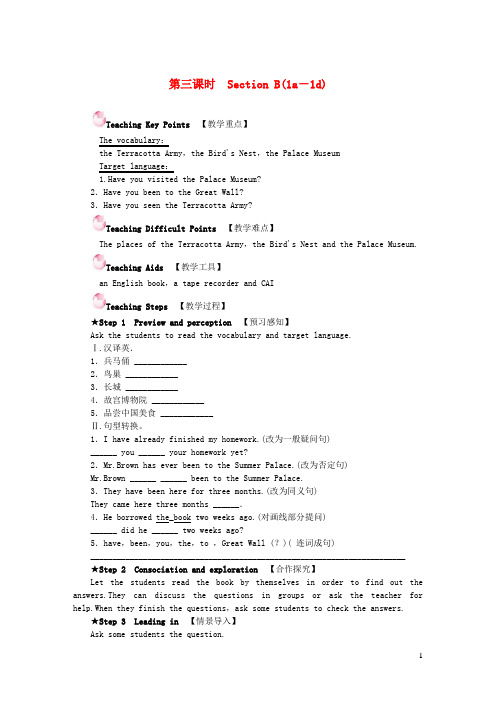
第三课时Section B(1a-1d)Teaching Key Points【教学重点】The vocabulary:the Terracotta Army,the Bird's Nest,the Palace MuseumTarget language:1.Have you visited the Palace Museum?2.Have you been to the Great Wall?3.Have you seen the Terracotta Army?Teaching Difficult Points【教学难点】The places of the Terracotta Army,the Bird's Nest and the Palace Museum.Teaching Aids【教学工具】an English book,a tape recorder and CAITeaching Steps【教学过程】★Step 1Preview and perception【预习感知】Ask the students to read the vocabulary and target language.Ⅰ.汉译英.1.兵马俑 ____________2.鸟巢 ____________3.长城 ____________4.故宫博物院 ____________5.品尝中国美食 ____________Ⅱ.句型转换。
1.I have already finished my homework.(改为一般疑问句)______ you ______ your homework yet?2.Mr.Brown has ever been to the Summer Palace.(改为否定句)Mr.Brown ______ ______ been to the Summer Palace.3.They have been here for three months.(改为同义句)They came here three months ______.4.He borrowed the_book two weeks ago.(对画线部分提问)______ did he ______ two weeks ago?5.have,been,you,the,to ,Great Wall (?)( 连词成句)________________________________________________________________________ ★Step 2Consociation and exploration【合作探究】Let the students read the book by themselves in order to find out the answers.They can discuss the questions in groups or ask the teacher for help.When they finish the questions,ask some students to check the answers.★Step 3Leading in【情景导入】Ask some students the question.Have you been to …?The students answer the question.Then practice in pairs.★Step 4Pre-task【准备任务】Page 69,1a1.Look at the pictures.2.Match the pictures with the names.3.Ask the students to check the answers.★Step 5While-task【过程任务】Page 69,1b&1c1.Look at 1b.2.Listen to a student interviewing a foreign student.Check the questions you hear.3.Ask one or two students to check the answers.4.Look at 1c.5.Listen again.Take notes.Then ask some students to check the answers.6.Ask the students to listen and repeat.★Step 6Post-task【后续任务】Page 69,1d1.Look at 1d.2.What places have you been to? Ask your partner.3.Ask the students to practice in pairs.★Step 7Consolidation practice【巩固练习】Look at the students' book of the 3rd exercise.★Step 8Summary【课堂小结】In this class we have listened to some tapes and practiced the sentence:Have you…? You should master it.★Step 9Homework【家庭作业】1.Review the phrases and sentences.2.Listen to the tapes twice after class.Board Design板书设计Unit 9Have you ever been to a museum?The third period Section B(1a-1d)1.The vocabulary:the Terracotta Army,the Bird's Nest,the Palace Museum 2.Target language:(1)Have you visited the Palace Museum?(2)Have you been to the Great Wall?(3)Have you seen the Terracotta Army?Section A 第二课时〔3a~4c)类别学习重点重点单词passenger, trouble, herself, onto, hit, off重点短语get off, right away, to one's surprise, get into, fall down, agree to do sth。
- 1、下载文档前请自行甄别文档内容的完整性,平台不提供额外的编辑、内容补充、找答案等附加服务。
- 2、"仅部分预览"的文档,不可在线预览部分如存在完整性等问题,可反馈申请退款(可完整预览的文档不适用该条件!)。
- 3、如文档侵犯您的权益,请联系客服反馈,我们会尽快为您处理(人工客服工作时间:9:00-18:30)。
课题Unit9 Have you ever been toa museum?课型New 课时Third教学目标1. Language goals: Target language: Have you ever been to a science museum?Yes, I’ve been to a science museum./No, I’ve never been to a science museum.Grammar:Grasp the Present Perfect Tense2.Ability goals: Explanation method. Exercise methods. To train st udents’ listening ,speaking andwriting skills3.Moral goal: To Encourage students to feel the world outside教学重点 1. The present perfect tense. 2. How to use the present perfect tense.教学难点To understand and use the present perfect tense.核心问题Present perfect tense with ever教学方法Understanding method. Task-based language teaching method教学环节教学活动学生活动设计意图Step 1 Warming up I. Greet with the students as usual.II. Pair work: Ask and answer questions with thestudents .Ask and answerquestions quickly andfreely.营造和谐融洽的课堂气氛。
Step 2 Pre-task 1. Ask students to read the sentences of Grammarfocus aloud. Revision the Present PerfectTense1.) 用法肯定式否定式I/You/We/They have finished the work.He/She/It has finished the work.I/You/We/They have not finished the work.He/She/It has not finished the work.构成:have(助动词) + p.phas(第三人称单数助动词) + p.p疑问式回答Have I/you finished the work?Has he/she finished the work?Yes, you/I have. No, you/I haven’t.Yes, he/she has. No, he/she hasn’t.have not常缩略为haven’thas not 常缩略为hasn’t现在完成时的用法Have you had your lunch yet?Yes, I have. I have just had it.(现在我不饿了)表示过去发生或已经完成的动作对现在造成的影响或结果。
Reading and writingTake notes课前复习现在完成时,让学生对于现在完成时有系统上的认识。
I haven’t seen her these days.I have known Bob for three years.I’ve been at this school for over two years.They have lived here since 1982.She has taught us since I came to this school.某些动词的现在完成时可表示过去某一时间开始并一直持续到现在(包括现在)的动作或者状态,可以和表示延续的时间状语连用。
表示持续动作或状态的是延续性动词。
ever 意为“曾经”,用于疑问句或否定句中,放在助动词与过去分词之间。
e.g. Have you ever been to Hong Kong?你曾去过香港吗?I haven’t ever spoken to her.我未曾和她说过话。
never意为“从来没有”常与before连用,多放在助动词与过去分词之间。
e.g. I have never travelled by plane before. 我以前从来没有乘飞机旅行过。
3.) 一般过去时与现在完成时的区别比较:I have seen the film..我看过这部电影。
(我了解这部电影的内容)I saw the film last month.我上个月看了这部电影。
(只说明上星期看了这部电影,不涉及现在情况)① 一般过去时只强调过去的动作;现在完成时强调过去的事情对现在的影响。
②一般过去时通常与表示过去的时间状语连用;现在完成时则不能与表示过去的时间状语连用。
③ 一般过去时单纯表示过去的经历;现在完成时表示过去的动作或状态延续到现在并可能持续下去。
一般过去时的时间状语有:yesterday, last week,…ago, in1980, in October, just now…共同的时间状语有:this morning, tonight, this summer, before, already, …现在完成时的时间状语有:for, since, ever, never, just, already, yet, in past years, …现在完成时与一般过去时是学生易混淆的两种时态,进行比较能使学生更清楚两种时态的区别及用法。
Step 3 While-task 1. Finish 4a on textbook. Put the correct form of theverbs in the blanks.1. A: Do you want ________ (come) to the spacemuseum?B: No, I’ve already ______ (be) there three times.2. A: Have you _____ (see) the robots at the sciencemuseum?B: Yes, I _____ (go) there last weekend.Finish 4a ,4b &4c理论通晓后,进行现在完成时的运用。
3. A: Let’s _______ (spend) the day at the zoo.B: Well, I’ve already ______ (be) there a couple of times, but I’m hap py _______ (go) again.4. A: How about ______ (go) to the art museum? There are some special German paintings there right now. B: Sure. When do you want _____ (go)?5. A: Have you ever _______ (visit) the history museum?B: No, I’ve never ______ (be) there.2. Finish 4b on textbook. Fill in the blanks with the correct forms of the verbs in brackets.Most of us ____________ (see) Mickey Mouse, DonaldDuck and other famous Disney characters in cartoons before. But have you ever ______ (be) to Disneyland? Disneyland ______ (be) an amusement park with a special theme — Disney characters and movies. There _____ (be) many exciting rides, lovely restaurants and fantastic gift shops there. You can also _____ (see) the Disney characters walking around the park. And have you ever _______ (hear) of a Disney Cruise? This ______ (be) a boat ride with a Disney theme. You can ______ (take) a ride on the boat for several days and eat and sleep on it. On the boat, you can ______ (shop) and have Disney parties before you ________ (arrive) at the Disney island.3. Finish 4c on textbook. Answer the survey questions and then ask your partner.4. Watching the pictures (1a)1) Show students some pictures about Section B1a from multimedia and let them watch them with the background music.2) After watching the pictures, ask them the following questions:.What can you see in the picture?.Which places are they?3. Listen to 1b and 1c.1) Listen to a student interviewing a foreign student. Check the questions you hear.2) Listen again and take notes.Step 3 Pair workUse the sentences in 1d to practice “What places have you b een to?”Read the passage bythemselves and learn thenew words by looking upin the dictionary.Finish the tasks on theirown. They can ask othersor the teacher for help.Watching the pictures.Answer the questionsListen and finish thetasks.Make their own conversations.动词的适当形式填空进一步加深对时态的理解和运用。
